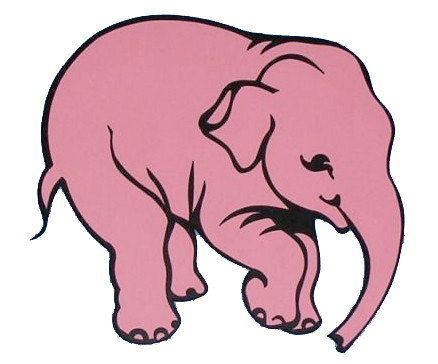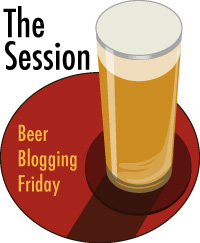![]()
I’ll Have a Beer, a.k.a. Andrew Couch, our host for the 33rd monthly Session, begins his explanation of this month’s topic — framing beer — with a compelling story:
My sister once told me a story she had heard about a sculpture exhibit: on the winter day it opened, the artist placed a coat rack next to the door. Predictably, the patrons hung their coats on it. Each day the artist moved the rack a bit closer to the rest of the exhibit, until the day came when the visitors chose not to use the “piece of art” for their coats. That day the artist placed a sign on the coat rack that stated simply, “Art begins here.”
Framing as a concept has been around a long time in academia as a part of such disciplines as linguistics, communications theory and similar social sciences. But it became more mainstream in 2004 with the publication of UC Berkeley professor George Lakoff’s book on the subject of framing in politics, Don’t Think of an Elephant.

Delirium Tremens’ pink elephant is my allusion to Lakoff’s book, and the idea of framing with regard to beer. But everything we write and say is framed, to one degree or another, as our language is very contextual. What words we choose and how we phrase our communications with one another gives a great deal of information, in some cases as much as the words themselves. The Republican Party is quite skilled at framing their agenda, calling an act that restricts people’s civil liberties “The Patriot Act” or a tax that falls disproportionally on the very rich a “Death Tax.” By calling it essentially the opposite of what it really is — as in say the Clear Skies Initiative that does little to make our skies any clearer — it’s easier to gain support for it since few people bother to look more closely at the substance. Take another example in the news lately: socialized medicine. Opponents of health care reform bandy this term around safe in the knowledge that people have a negative reaction to it. But it is almost meaningless. The term was crated by a PR firm on behalf of the American Medical Association in the late 1940s when Harry Truman had the temerity to try to reform health care then. The Cold War was just heating up and the PR firm correctly figured that by calling it “socialized” people with associate it with communism. This despite the fact that in school we all learned that we’re a social democracy and that the police department, fire department, post office, medicare, social security, unemployment and all manner of programs that make our lives better and few people would want to do without are forms of socialism. No matter, the framing of it has everything to do with how people react to it.
Framing isn’t necessarily as sinister as that suggests, and in fact more often than not it does accurately reflect the intentions of the communicator, especially outside politics. It’s only when framing is misused to manipulate that it takes a more sinister turn. When it comes to beer, not so much. But almost everything about a beer can be described in those terms, from the packaging to the beer’s name, style designation and label.
Couch describes this phenomenon with regard to beer:
Imagine persuasively describing craft beer to someone who has until now entirely missed out, maybe in a sales situation. Perhaps it’s a brown ale and you can can describe the caramel and toast flavors, or it’s a pale ale and you have fruit or herbs from the hops. You might start having to defend yourself if it’s an IPA and those hops taste earthy, resiny, or particularly bitter. You’ll definitely meet some resistance if your favorite is an imperial anything, brimming with intensity and a sharp kick, or if you’d like to convince a person of the credibility of a sour beer or anything for which you must use the word ‘funky’. Each of these descriptions is inevitably an attempt to ‘frame’ the beer, putting the consumer in the proper state of mind to drink it.
For better or worse, in everyday situations beer comes with a label. This label very really ‘frames’ the beer inside. The fact that the beer comes commercially-produced signals the presence of investment (if not skill). A style name or tasting notes indicates the general characteristics to expect. If you know the brewery the beer is framed with your past experiences. Even the label art will affect your expectations for the beer.

Then Couch goes on to the assignment at hand:
What role does this framing play in beer tasting, especially for ‘professional evaluators’? Relate an amusing or optimistic anecdote about introducing someone to strange beer. Comment on the role a label plays in framing a beer or share a label-approval related story. I have not done much blind tasting, and I would be intrigued to hear about this ‘frameless’ evaluation of beer.
And drink a beer. Ideally drink something that you don’t think you will like. Try to pick out what it is about that brew that other people enjoy (make sure to properly frame the beer!).
As for tasting blind, it’s virtually a necessity for competitive judging. Being human, we all bring our prejudices and bias to the tasting table, no matter how much we try to avoid it. I can’t tell you how many times I’ve been surprised to discover what a beer I tasted blind was, freed from expectations and even faulty memories. One of the things that’s stressed at GABF judging is that if you think you can identify a beer you’re sampling blind, keep it to yourself. Not only are you usually wrong, but you’ll unduly influence others at the table. Memory is a curious thing, and I’ve read a great deal about it in the context of courtroom testimony where it’s not nearly as reliable as one might expect. More recent scientific inquiry is revealing just how poorly our memories can be. So anything we can do to remove those and any other bias, goes a long way toward making beer judging better and more fair for the beers being judged.

One of my favorite beers to get people thinking differently about beer and what beer is and can be is Unibroue’s Quelque Chose. When it was more widely available, I used to serve it each year at an annual Christmas party we’d throw before the kiddles came along. Quelque Chose is French for “something different” and that it is. If you’re not familiar with it, Quelque Chose is an 8% abv dark beer fermented with wild cherries and intended to be served hot, around 160° F. Essentially you mull the beer in a pot filled with water. It was originally created to service the ski regions northwest of Montreal and it’s absolutely divine on a cold night.
But what makes it is seeing people’s faces the first time they try a hot beer that also tastes good. It’s priceless because it’s so far removed from their normal experiences with beer. In a sense, they’re so far outside the frame that they’re forced to see beer in a whole new way and, hopefully, it will be difficult for them to go back to the old view. As a result, this beer is perfect for turning people on their head. It can’t fit into the frames of colder and colder beer that the big breweries have been crowing about and the experience should suggest that cold beer is not always better. Actually, I’d argue it’s rarely, if ever, better, but then I feel most American bars serve their beer too cold already, robbing people of all the flavor they should be enjoying.
I think the usual frames — beer styles, labels and reputations — are double edged swords that are equal parts good and bad, depending on specific circumstances. All we can really do is be aware of them and how they influence us.
